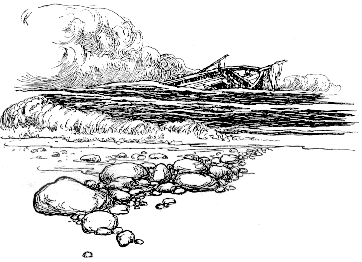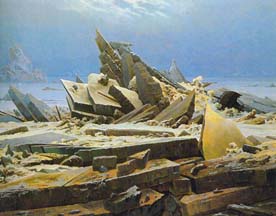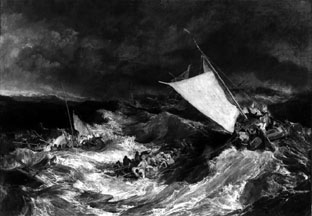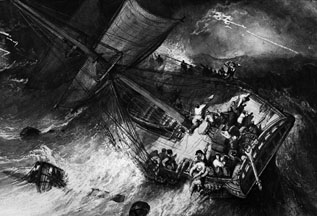
Rockwell Kent's illustration for Moby Dick.
The moment of actual shipwreck is not the only form in which the situation of the imperilled mariner appears. There is, first of all, the moment when the sailor realizes that he is lost and can obtain no bearings. Then, after he has drifted hopelessly, there comes the instant his ship crashes upon a rock or is overwhelmed by raging seas; and this is followed by the moment the mariner strikes the water, a swimmer in the waste, cold ocean . Last comes the time when he drags himself ashore only to find himself on a hostile desert island.
This typology, which proceeds by arranging different situations and structures to make up a hypothetical master narrative, can be illustrated by many nineteenth- and twentieth-century paintings. Thus, Winslow Homer's Lost on the Crand Banks (1885, John S. Broome Coll.), which portrays several figures in a dory peering anxiously through the gray world surrounding them, exemplifies the first stage, while his Gulf Stream (1899, Metropolitan Museum of Art, Pl. 6) depicts a drifting, damaged vessel about to be destroyed by final disaster, which we see approaching in the form of a waterspout. John Sell Cotman's Dismasted Brig (c. 1823, British Museum) offers another variation on this theme: the painter presents his stricken ship, which has already lost one of its masts, in profile against an enormous iceberg that dwarfs it, and Delacroix's Shipwreck on the Coast (c.1862)[Anderson Trapp, Frank. The Attainment of Delacroix (1971) Baltimore: 18n, comments upon the importance of the metaphor of the wrecked boat to the artist.], carried a vessel even closer to final disaster, showing it after it has become completely dismasted and nothing more than a drifting hulk - a situation presented with even more power in Clarkson Stanfield's The Abandoned (1856, location unknown).[Stanfield's untraced picture is illustrated in Great Victorian Pictures, Their Paths to Fame, the catalogue for the 1978 Arts Council exhibition organized by Rosemary Treble. See p. 93 for a reproduction of the painting and an anthology of contemporary comments about it.]

William Heath Robinson, pen-and-ink illustration reproduced by photographic process. Rudyard Kipling, Song of the English. London: Hodder and Stoughton, nd, p. 55. This volume, one of the truly great works of early twentieth-century British book illustration, includes many images of maritime disaster both in this stark black-and-white style and, in the form of tipped-in plates, in an entirely different style involving translucent watercolor reminiscent of the early work of Edmund Dulac.
The Scandinavian artist J. C. C. Dahl takes us one step farther, as it were; his Shipwreck on the Norwegian Coast (1832, National Gallery, Oslo) presents a dismasted vessel which smashes itself against a rocky coast that curves round the left side of the canvas. Dark, stormy skies look down upon the disaster, creating a powerful image of the ways the sea and the heavens crush man's ships and his hopes. William Heath Robinson shows one end to the narrative as a hulk protrudes from the surf at water's edge.
This situation of the ship destroyed against the coast is always laden with irony because it demonstrates how even the approach to land, which should be an approach to safety, can cause final destruction. Variations upon this very popular pictorial subject appear in George Morland's undated Shipwreck (private coll.) and identically entitled works by Francis Danby (1843, James White Coll., Dublind and Eugene Isabey (n.d., Museum of Art, Rhode Island School of Design), Homer's Wrecked Schooner (c.1903, St Louis Art Museum) and Turner's Wreck of a Transport Ship (c. 1810, Gulbenkian Foundation Lisbon).
(Left) Clarkson Stanfield, Wreck of the 'Avenger', watercolor, guache, and pencil. 10 1/4 x 15 1/4 inches. n.d., courtesy of Whitworth Art Gallery, Manchester. (right) J. M. W. Turner, Shipwreck, oil on canvas, 1805, Tate Gallery, London.
This last painter's 1805 Shipwreck moves the victims farther out to sea but still in sight of land, while his Fire at Sea (c. 1835, Tate Gallery) portrays the disaster on the open, empty ocean. Stanfield's Wreck of the 'Avenger' depicts the stricken vessel, which fills most of the canvas, from the stern as it heels at forty-five degrees in raging wind and seas. Beneath dark skies streaked by lightning the crew scrambles to secure hold on the port rail to keep from being carried overboard. A mast and other wreckage already float free, and we know it will not be long before the ship goes down. John Brett's Shipwreck (n.d., Bournemouth Museums) and Danby's Shipwreck against a Setting Sun (c. 1850, Paul Mellon Coll.), which also take place on the open sea, represent the next stage of maritime disaster since the sailors have already taken to the lifeboats and abandoned their doomed ships.

The next stage, that of the castaway, is represented by I. K. Aivazovskii's The Ninth Wave (n.d., Leningrad). Heavy fog obscures the upper portion of the scene, and in a mist-free section below we glimpse several figures hanging and sitting on the remains of a mast amid high waves. This figure of the castaway or swimmer, which is related to representations of the dying Ophelia by Millais (1852, Tate Gallery) and Delacroix ( 1853, Louvre), also appears in Turner's Slave Ship (1840; plate and discussion) and Delacroix's Bark of Dante (or Dante and Virgil; 1822, Louvre).
Géricault's The Raft of the 'Medusa' (1819, plate and discussion), one of the most important and influential images created by the Romantic imagination, provides another version of the castaway situation. Having been saved from immediate death when their vessel went down, the survivors boarded a raft and were then abandoned by the lifeboat towing them, and afterwards many of them perished from hunger, thirst, and exhaustion. Géricault has chosen to portray that instant the survivors struggled desperately but in vain to attract the attention of a passing rescue vessel. The Raft of the 'Medusa', then, depicts, not the moment of the imperilled mariners' salvation, but that in which their hopes were crushed. [Lorenz Eitner, Géricault's 'Raft of the "Medusa" ' (London, 1972), which contains the definitive discussion of the evolution of the painting, points out that the sighting of the other vessel 'is not part of the rescue, it is, rather, the ultimate ordeal of the shipwrecked men.... [It] is a scene of anxiety, disappointment, and resignation rather than relief' (p. 26). His valuable discussion of the artist's use of compositional devices and juxtaposition of distances to dramatize his point occurs on p. 31.]
A third variation upon the theme of the ironies of being saved appears in Philip de Loutherbourg's Survivors of a Shipwreck Attacked by Robbers (1793, Southampton Art Gallery), for having escaped the dangers of nature the victims are destroyed by their fellow men. [Such treatment of the survivors of shipwreck so disturbed William Falconer, himself a mariner, that he devoted a long passage to the subject in The Shipwreck. According to Elizabeth Schneider, The Dragon in the Gate: Studies in the Poetry of G. M. Hopkins (1968): Berkeley and Los Angeles, 17, Englishmen were shocked to learn when the Deutschland perished that 'no attempt at rescue had been made for some thirty crucial hours; and subsequently the vessel was looted by the owners of local fishing smacks who, it was said, even tore rings from the fingers of the dead bodies on board.'] Like de Loutherbourg's painting, Homer's After the Hurricane (1899, Art Institute of Chicago) presents a grimly ironic image of the castaway, the survivor of shipwreck, who has reached land but has not survived. This version of death by water thus resembles George Frederic Watts's Found Drowned (c. 1866, Walker Art Gallery Liverpool) and Vassily Grigorievich Perov's The Drowned Woman (1867, Tretyakov Gallery, Moscow).

Thomas Bewick. Wood-engraving. From an 1865 re-publication reproduced in 1800 Woodcuts by Thomas Bewick and His School. Edited by Blacne Circker. NY: Dover, 1962.
Yet another intonation of this image of man's fate appears in many nineteenth- and twentieth-century pictures of wreckage on the shore, such as James Clarke Hook's Wreckage from the Fruiter (n.d., Tate Gallery). Edward Wadsworth's Requiescat (1940, Leeds City Art Gallery) portrays the aftermath of war, presenting an image of a shore strewn with the ribs of shattered boats which resemble nothing so much as the rib cages of dinosaurs and other extinct monsters. This wreckage and those shattered hulks are all that remain of life's journey.
 One may take the German painter Caspar David Friedrich's Sea of Ice (or Arctic Shipwreck; 1823-4, Kunsthalle, Hamburg) as a type of this theme in nineteenth-century painting: only the stern of the vessel remains visible among the crushing heaves of jagged ice which mark the desolation of an arctic wasteland.[For a discussion and bibliography concerning this painting, which was long misidentified as the untraced Wreck of the 'Hope' see La Peinture allemande a l'epoque du Romantisme (1976), Paris: 64-5. The painting was
purchased in 1843 by J. C. C. Dahl.] Bits and pieces of shattered masts lie wedged in among the pyramids of ice which rise into an empty, paleblue sky, creating a powerful emblem of life's end amid the failure of hope, of hope crushed by destiny and the forces of nature. All is cold, dead, jagged - and the sun shines brightly on the crushed hopes of man.
One may take the German painter Caspar David Friedrich's Sea of Ice (or Arctic Shipwreck; 1823-4, Kunsthalle, Hamburg) as a type of this theme in nineteenth-century painting: only the stern of the vessel remains visible among the crushing heaves of jagged ice which mark the desolation of an arctic wasteland.[For a discussion and bibliography concerning this painting, which was long misidentified as the untraced Wreck of the 'Hope' see La Peinture allemande a l'epoque du Romantisme (1976), Paris: 64-5. The painting was
purchased in 1843 by J. C. C. Dahl.] Bits and pieces of shattered masts lie wedged in among the pyramids of ice which rise into an empty, paleblue sky, creating a powerful emblem of life's end amid the failure of hope, of hope crushed by destiny and the forces of nature. All is cold, dead, jagged - and the sun shines brightly on the crushed hopes of man.
This arrangement of these various situations of maritime disaster to form a hypothetical master narrative is a useful critical tool for the iconsologist, for it permits him to relate widely differing situations to one another. Furthermore, by treating them as discrete stages, he preserves the individuality and uniqueness of each particular situation. Such a procedure, in other words, permits one both to perceive the general relation of individual situations and structures to some overall paradigm and then, once this general relation has been perceived, it then encourages one to discriminate carefully among the various forms or stages in which the imperilled mariner appears. By thus placing various situations in this kind of narrative progression, I do not mean to imply that artists and authors who employed them regarded their images, metaphors, and subjects in this manner. My arrangement, in other words, is hypothetical - a research tool that promises to allow and even encourage the student of iconology to study such matters more efficiently. It certainly does not pretend to describe a nineteenth- or twentieth-century planbook or handlist of tropes and subjects.
The principle of transformation, which underlies all my attempts to relate various situations, structures, and tropes, here takes a chronological (or diachronic) form, whereas when I tried to demonstrate a common structure underlying the very different situations experienced by the victims of shipwreck, avalanche, and Etna, the transformation appeared in a on-chronological (or what structuralists somewhat misleadingly call a synchronic) form. The principle of transformation, moreover, also appears in this second form when one relates any individual stage of maritime disaster to the main cultural paradigm, which in this case is the Christian conception of life as a journey. Each individual form of the situation of maritime disaster exists as a transformation — specifically, an inversion and denial - of the entire Christian paradigm, but it also frequently turns out to be a transformation of a stage, or sub-paradigm, of the Christian journey of life. For example, as I shall demonstrate in the following pages, the post-Christian situation of the lost and drifting mariner and vessel serves as precisely such a transformation of the commonplace Christian metaphors of Christ guiding one's vessel. Similarly, the moment when the voyager's destination disappears transforms the entire Christian notion of a purposeful journey or pilgrimage.
Last modified 15 July 2007


